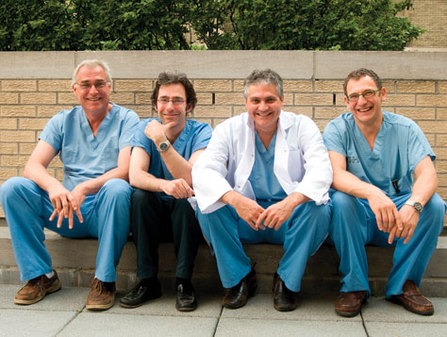
Jean Raymond, François Guilbert, Daniel Roy and Alain Weill from the Department of Radiology, CHUM, Notre-Dame Hospital, Montreal, Canada, and Tim E Darsaut, University of Alberta Hospital, Mackenzie Health Sciences Centre, Department of Surgery, Division of Neurosurgery, Edmonton, Canada, spoke to NeuroNews about the hope, hype and hoopla surrounding flow diverters, and why the most important aspect of the FIAT trial is not the scientific knowledge gained but the protection of patients.
Why is there so much excitement regarding flow diverter stents?
There is always some element of hype surrounding the introduction of new devices. In this case, the excitement is founded on case reports and series that are truly impressive: flow diverting stents have shown the capacity to cure some difficult intracranial lesions such as giant aneurysms while preserving the parent vessel. In addition, the technique is relatively simple, at least as compared to other treatment alternatives.
What key questions will the FIAT trial address, and why are these questions important?
Key questions that will be addressed by FIAT concern the safety and efficacy of the use of flow diverters, compared to other management options, such as conventional coiling ± stenting, parent vessel occlusion, surgical clipping, or conservative management. While some may think this can be accomplished using observational studies, this is simply not possible.
The absolute number of complications that are recorded in a registry are meaningless, as they are observed without a proper control group. For example, if the flow diverter is used only for high-risk complex cases, poor results might deter the adoption of an innovation that might have been truly valuable. On the other hand, if use of the new device is restricted to only simple cases, where the device will be expected to perform well, many patients who might benefit from a flow diverter might be denied access to a promising treatment option. It is impossible to know where patients fall all along this spectrum, and because registries do not have a control group, the results can never inform us regarding the best type of treatment for our patients.
What is most important in FIAT is not the scientific knowledge that will be gained. The most important aspect of FIAT is the protection of patients. FIAT allows the introduction of a new treatment under the protection that only randomised, controlled trials can offer. No matter how exciting a new device is, there is always uncertainty, unforeseen secondary effects and complications at the beginning of any clinical experience. Patients must be protected from fashion, enthusiasm, and learning curves by offering them a 50:50 chance of access to the new tool; but also a 50:50 chance of avoiding unforeseeable device-related complications.
Because some patients cannot be treated any other way, there is a registry part of FIAT designed to include all patients. We expect these patients to be few.
What are some of the potential downsides of using flow diverters without adequate evidence?
We have already seen complications that are not clearly understood from using flow diverters, such as ruptures of previously unruptured aneurysms following treatment.
Practicing medicine without adequate evidence can only lead to suboptimal care. Neurointerventional procedures are performed in highly specialised, typically academic centres. If first-time users of medical innovations in supra-specialised centres do not provide adequate evidence and do not protect patients from wishful thinking, enthusiasm and fashion, who will? Using new devices without adequate evidence, outside a proper trial, can be viewed as an abuse of the powers granted to physicians.
What is your message to clinicians on usage of flow-diverters?
All clinicians who wish to offer treatment with a flow diverter to their patients are welcome to participate in FIAT. When a physician chooses to participate in FIAT, they can be assured that their patient will receive optimal medical care: randomised allocation to treatment with a flow diverter or to what the clinician judges is the most appropriate conventional alternative.
For more information on the trial or if you want to join the study:Ruby Klink, [email protected] or www.clinical-care-trials.org











